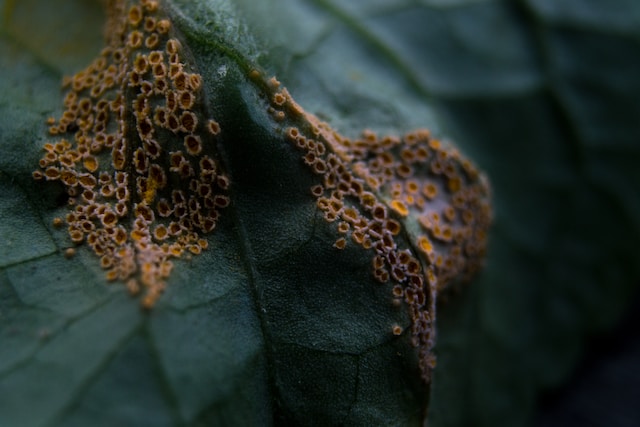
If you are a plant lover, whose plants have suddenly shown retarded growth symptoms, be sure to learn to Identify and Treat these Common Plant Diseases before throwing them out. Plant disease identification is super easy when you know its characteristic symptoms. Once you have recognized the causative agents then it becomes easier to choose a treatment method that will cure disease without doing any harm to your plants.
Common Plant Diseases:
1. Rust
Rust is caused by a group of fungi called rust fungi which affects the various parts of various plants. Rust fungi most commonly affect the leaves but it can also infect stems, fruits, or flowers.
Symptoms:
Spots of rust vary in color but are converted into spore-producing pustules. Spots may be yellow, brown, or black but they have a rusty appearance.
Favorable conditions:
- Wet weather and high humidity (rain, heavy dew)
- Optimal temperature range of 77-86°F and even cooler.
Control:
Rust fungi are the most difficult ones to deal with because they can affect a wide variety of plants within the premises of your garden.
- To prevent rust from spreading you can discard the infected plants and quarantine the new plants in case they have invisible rust spores in them.
- These pores are soil born so all water carefully to avoid soil splashing upon the leaves.
- Don’t spray water directly on the leaves.
- Don’t let water stay on the leaves for up to six hours or more.
- Disinfect the equipment with the use of disinfectants.
2. Early Blight and late blight
Blight is a common fungal plant disease of tomatoes. Whether in the home gardens or commercial settings, blight can significantly damage your precious tomatoes. Apart from tomatoes, blight can affect various vegetables including pepper, eggplants, and potatoes.
Favorable conditions:
Warm and humid conditions of air or soil
Symptoms:
Yellowing or Browning of leaves which starts from the lower surface and spreads to the upper surface of the leaves.
These spots having a mushy texture may also be visible on fruits of infected plants.
Control:
- Crop rotation is an effective preventive measure for blights.
- Along with crop rotation observe proper space between plant rows to allow ventilation.
- Cut and separate diseased leaves, fruits, or stem to avoid further spread of infection.
- Keep area debris free and don’t spray water directly on leaves.
- Keep tools and equipment sterile /disinfected (use common house disinfectants)
- Use organic or inorganic fungicides
3. Downy mildew
Caused by oomycetes, it affects many agriculturally important plants including Cucurbits, Brassicas/Crucifers, Grapes, Basil, Roses, and Spinach.
Symptoms:
Unlike powdery mildew which gives a powdery appearance, downy mildew Has a pale yellow appearance. These fungi-like-organisms (water molds) grow on the underside of the leaves below these spots and have Gray color once matured. The infection starts from the upper surfaces of the order leaves.
Favorable conditions:
Airborne spores are favored by wet weather and prolonged wetness on the leaves.
Control:
- Avoid watering in the evening or on directly on the leaves
- Proper plant spacing
- Cut and discard infected parts
- Crop rotation
- Use resistant varieties
4. Black spot:
It is one of the most common plant diseases caused by fungi that are encountered by garden owners. It attacks ornamental plants, especially roses.
Symptoms:
Black round spots on the leaf that prevail from the lower side of the leaf and reach the upper side as well, yellowing of leaf due to loss of chlorophyll which eventually leads to premature fall off of the leaf.
Favorable environment:
- Soil or air humidity (wet weather or over-watering that extends 6 hours)
- Excessive plant debris (favorable environment for pathogen spores to germinate)
Control:
- Make sure that soil is well-drained and avoid over-watering. You can try to boost the plant’s natural defense system against pathogens i.e. by the addition of organic fertilizers. Don’t let water stand on the leaves.
- Remove plant debris regularly to keep the environment clean.
- Keep infected plants away from the healthy ones. And don’t forget to use disinfectant for your pruners otherwise you may unknowingly carry infection from one plant to another.
5. Powdery mildew:
Identification of powdery mildew is easy as it affects almost all landscape plants including fruits, vegetables, and flowers. This too, is caused by fungus.
Symptoms:
White powder on the plant (hence the name powdery mildew). You can easily witness it on the upper surface of the leaves of infected plants but it is not limited to leaves only.
Favorable conditions:
- Low soil moisture and high air humidity, unlike black spots which thrive in wet weather.
- Shady plants are more prone to infection as compared to those which grow in direct sunlight.
Control:
Trim to remove the infected parts so that infection does not spread to the rest of the plant. The debris of infected plants has spores that will infect healthy plants, so it is advised to keep this debris away from healthy plants. Keep plants in open sunlight.
Conclusion:
Common plant diseases don’t have to be devastating for your home garden. Simple techniques like leaf damage identification can help you treat your precious plants at home.